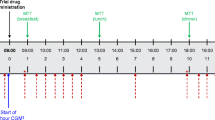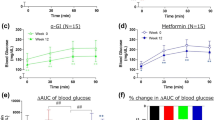Abstract
OBJECTIVE: Prandial glucose regulation has the potential for achieving good metabolic control with a low risk of hypoglycaemia and increased flexibility with regard to eating patterns. Comparative studies have suggested that the prandial glucose regulator repaglinide is at least equivalent to sulphonylureas in terms of efficacy, but incurs a lower risk of major hypoglycaemia. However, these trials employed fixed dosing and mealtime regimens, so repaglinide was not used as intended. This prospective investigation in a daily clinical setting aimed to assess the efficacy and tolerability profile of flexible prandial glucose regulation with repaglinide in Type 2 diabetes.
DESIGN: 5985 patients with Type 2 diabetes in Germany were surveyed prospectively. These patients were assessed before and after a mean of 46 days treatment with repaglinide. At baseline, available data showed that 64% of patients had previously received therapy with conventional oral antidiabetic drugs, 22% were on diet alone, and 13% were naïve to any treatment.
RESULTS: Overall, mean HbA1c decreased from 8.6 to 7.4%, fasting blood glucose from 183.9 to 134.2 mg/dl (10.2 to 7.4 mmol/l), blood glucose prior to main meals from 198.5 to 141.4 mg/dl (11 to 7.8 mmol/l), and blood glucose 2 hours after main meals from 219.3 mg/dl to 153.2 mg/dl (12.2 to 8.5 mmol/l).
Subgroup analysis showed significant improvements in each of these parameters (P<0.0001) in therapy-naïve patients, in patients switched from other oral antidiabetic drugs, and in patients receiving repaglinide as combination therapy. Body weight decreased slightly (1.2±2.7 kg). Only 49 hypoglycaemic episodes were reported, of which 38 cases were mild and no adverse sequelae to these events have been reported. Repaglinide also led to a liberating effect on lifestyle when patients were switched from other oral hypoglycaemic agents (OHAs), with 80% reporting a sense of relief at the prospect of being able to miss meals. The proportion of these patients reporting lifestyle restrictions as a result of fixed mealtimes declined from 36% to 7%. Before switching, 38% of the patients admitted to eating when not hungry for fear of hypoglycaemia, but only 10% continued this behaviour and patients took fewer supplementary snacks after switching to repaglinide.
CONCLUSION: Prandial glucose regulation with repaglinide improves metabolic control in patients with Type 2 diabetes without causing weight gain and with few hypoglycaemic episodes. This beneficial effect is seen in patients who are therapy-naïve, have switched from alternative OHAs, or are in need of combination therapy. The prandial approach to treatment has a liberating effect with regard to eating behaviour that is welcomed by most patients switched from alternative therapies.
Similar content being viewed by others
Author information
Authors and Affiliations
Rights and permissions
About this article
Cite this article
Landgraf, R., Frank, M., Bauer, C. et al. Prandial glucose regulation with repaglinide: its clinical and lifestyle impact in a large cohort of patients with Type 2 diabetes. Int J Obes 24 (Suppl 3), S38–S44 (2000). https://doi.org/10.1038/sj.ijo.0801424
Published:
Issue Date:
DOI: https://doi.org/10.1038/sj.ijo.0801424
- Springer Nature Limited
Keywords
This article is cited by
-
Alpha-glucosidase inhibitors and hepatotoxicity in type 2 diabetes: a systematic review and meta-analysis
Scientific Reports (2016)
-
A review of methods used in assessing non-serious adverse drug events in observational studies among type 2 diabetes mellitus patients
Health and Quality of Life Outcomes (2011)




